Our recommendations are made independently. We may receive commissions from purchases made via our links.
19 Types of Cuts Every Cook Should Know
Learn about the basic cuts and how to perform the cuts with a knife. Distinguish Batonnet, Julienne, Paysanne, among other formal and informal cuts in French cuisine.
You are probably familiar with the word “julienne”, which roughly means to cut the food into long, thin, matchstick-like strips. The julienne is one of the many different types of culinary cuts. These cuts vary in size and shape, each having its own name, measurement, and specific purposes and applications.
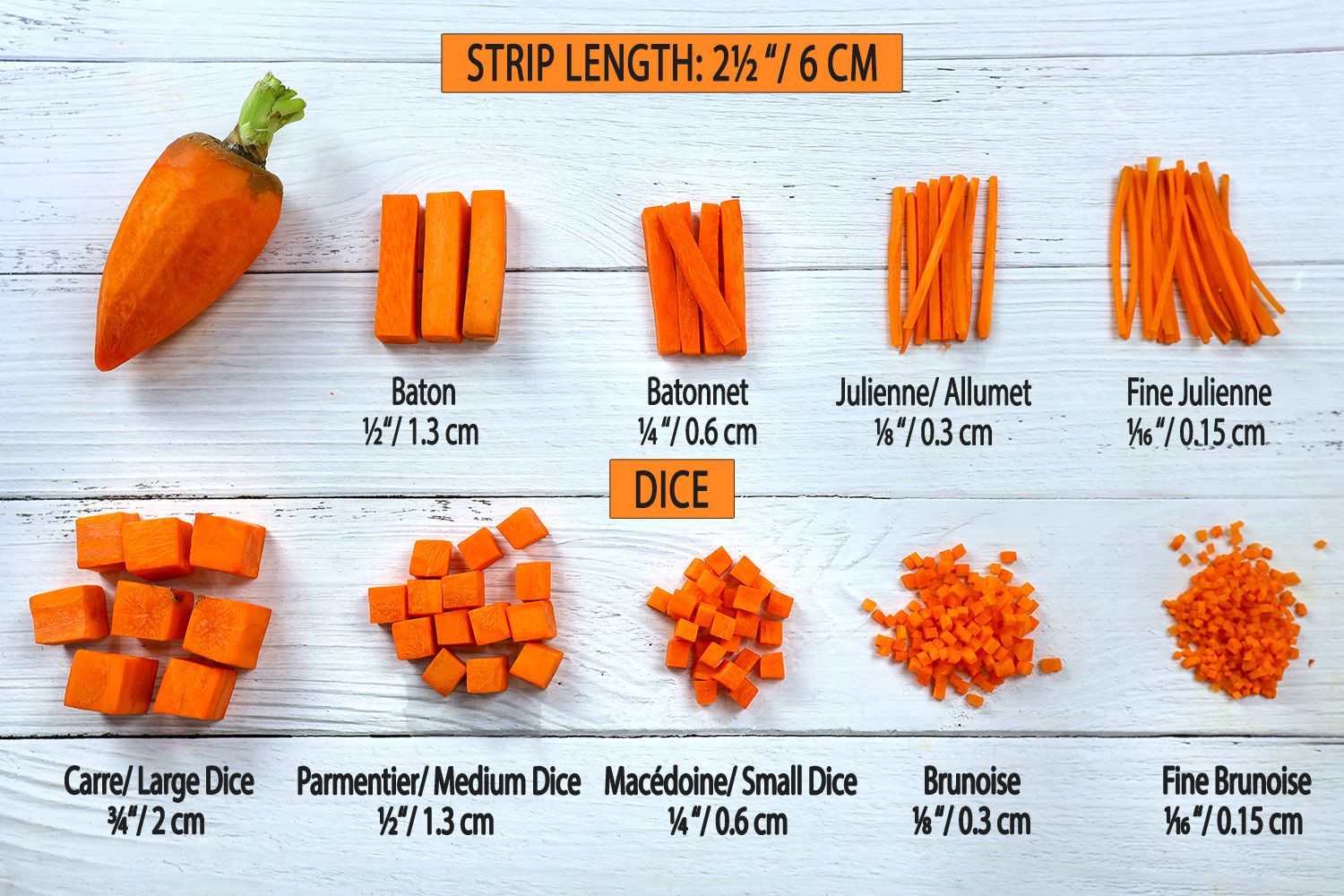
The types of cuts are more than just culinary finnicks. The way ingredients are cut can affect the texture, flavor, and appearance of the final dish. When the food is cut into the same shape and size, they’re more likely to absorb the spices and cook evenly. Aesthetics-wise, the uniformity of an ingredient also makes the dish more appealing.
These cuts are an essential aspect of cooking, and understanding their differences and uses is crucial for any aspiring chef, especially those aiming to work in high-end restaurants or graded areas. At a culinary school, you may have to perform these cuts even before learning how to sharpen your knives properly.
Without further ado, equip yourself with a chef knife, santoku, or nakiri bocho (yes, the type of knives used matters too!), and let’s take a look at the most popular cuts, their applications, and how to perform them.
Basic Strips Cuts
Pont Neuf
Applications
The pont neuf cut is mostly used on potatoes and is not as popular as other strip cuts due to its larger size.
- French fries: The pont neuf cut is the traditional cut for French fries. In fact, the name for French fries with this cut is pommes pont neuf. The potatoes are usually double-fried to create a crispy exterior and fluffy interior.
- Roasted potatoes: The pont neuf cut can also be used for roasted potatoes. The thick, rectangular pieces cook evenly and develop a crispy exterior while remaining tender on the inside.
How to Perform the Pont Neuf Cut
- Pick a large French fry potato (at least 3 inches or 8 centimeters in length).
- Remove the ends of the potato so it reaches a length of 2 ½ inches.
- Cut the four sides of the potato lengthwise to create a large ¾ inch thick rectangular slab.
- Cut the slab into ¾ inch strips.
Depending on the shape of the potato, it’s sometimes only possible to produce one Pont Neuf strip out of it. In some places, however, the exact shape of the strips can be flexible to make the most out of the potato.
Bâton

Applications
The bâton is used in a wide variety of dishes.
- Garnishes: Batons can be used as a decorative garnish on top of dishes, such as salads, to add texture and visual appeal.
- Roasted vegetables: Roasting vegetables, such as carrots or potatoes, in baton shapes can help them cook evenly and develop a crispy exterior while remaining tender on the inside.
- Finger foods: Batons can be used to make bite-sized finger foods, such as vegetable sticks or fruit skewers, which are easy to eat and perfect for entertaining.
How to Perform the Bâton Cut
- Start with a vegetable or fruit that has a uniform shape, such as a carrot or a potato. Trim off the ends and cut it into 2 ½ inches long sections. Trim the sections to make thick cuboids..
- Cut each cuboid into slabs that are about ¼ inch thick.
- Cut each slab lengthwise into strips that are about ¼ inch wide. These are the bâton cut pieces.
Bâtonnet
The bâtonnet is a stick that has the same length and half the depth and width of the bâton.
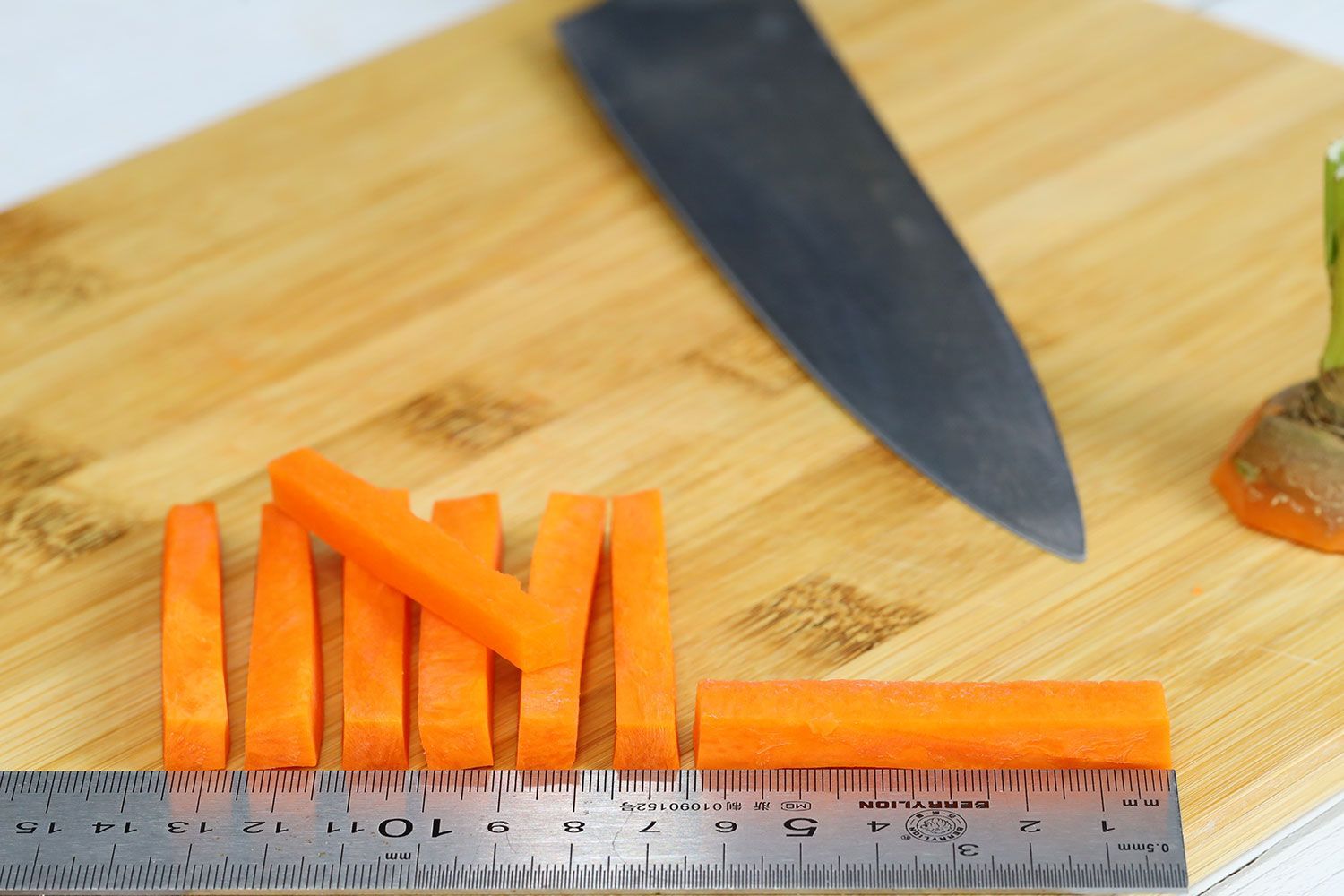
Applications
- Stir-fry dishes: Many stir-fry dishes, such as beef and broccoli or chicken and vegetables, call for thick vegetable strips for a crispy texture.
- French Fries: In many places, French fries are made from potatoes that have been cut into bâtonnets and then fried until crispy.
- Crudité Platters: Vegetables, such as carrots, celery, cucumbers, and peppers, are often cut into bâtonnets for a classic French-style crudité platter.
How to Perform the Bâtonnet Cut
- Using a knife, remove both ends of the food you’re batonneting (usually something dense such as a carrot, cucumber, or beetroot). Cut it into 2 ½ inch long portions.
- Cut the sides of each portion until it becomes a rectangular shape.
- Cut those pieces into 1/4 inch slabs.
- Cut the slabs lengthwise into 1/4 inch strips.
Julienne (or Allumette if it’s a potato)
The julienne is a stick that has the same length and half the depth and width of the bâtonnet.

Applications
- Salads: Julienne-cut fruits and vegetables such as carrot, beet, cucumber, apple, pear, etc can add interesting colors, flavors, textures, and nutrition to any salad.
- Spring rolls: Thin, long strips of carrots, cucumbers, taros, and jicamas are often used as a filling in spring rolls, along with protein and herbs.
- Coleslaw: Julienne-cut cabbage and carrots are a classic base for coleslaw, which can be dressed with a variety of dressings.
- Sushi: Julienne cuts of vegetables, such as cucumber or carrot, are commonly used in sushi rolls to add a crunchy texture and fresh flavor.
How to Perform the Julienne Cut
As thin as julienne strips are, they are actually thicker than those produced by the typical Julienne peeler. Thus, we don’t recommend using the peeler for this cut. Here are the steps to perform it with a chef knife or vegetable knife.
- Wash and trim the ends of the fruit/vegetable. Remove any unwanted parts (seeds, peel, or uneven parts)
- Cut the vegetable into 2 ½ inch long portions. Cut the sides of each portion until it becomes a rectangular shape.
- Cut the cuboids into 1/4 inch slabs.
- Cut the slabs lengthwise into 1/4 inch strips.
Fine Julienne
The fine julienne is a stick that has the same length and half the depth and width of the julienne.
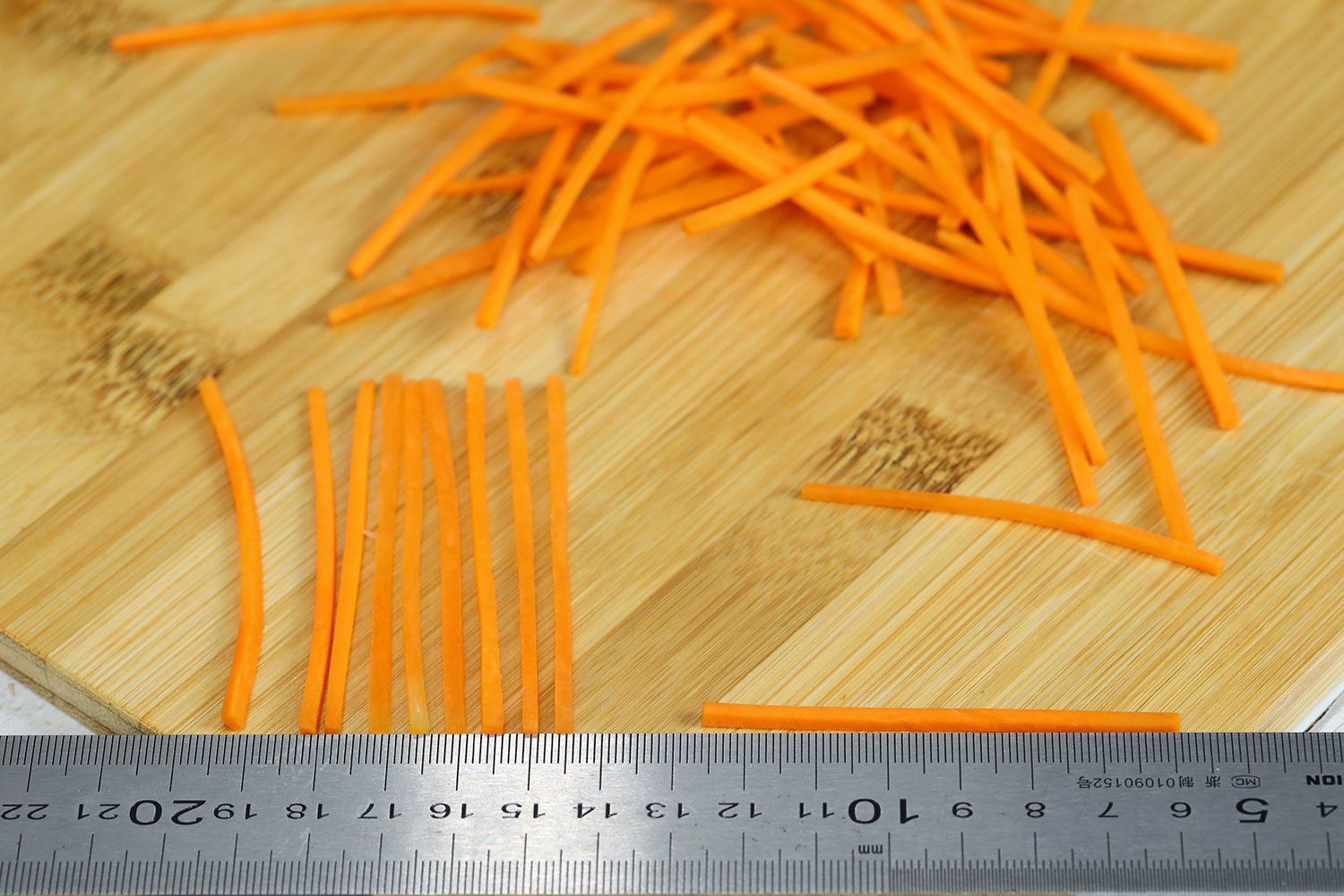
Applications
- Garnishes: Fine strips of carrots, peppers, or zucchini are popular garnishes for soups, stews, and salads. They can add a beautiful pop of color and texture to the dish.
- Pasta dishes: Finely julienned vegetables can be mixed into pasta dishes to add some extra texture and nutrition. They can also be used as a topping for pasta dishes or as a filling for ravioli or other stuffed pasta.
- Coleslaw: Fine julienne cut cabbage and other vegetables can be used to make a classic coleslaw. The thin strips allow the dressing to coat them evenly, resulting in a delicious and refreshing side dish.
How to Perform the Fine Julienne Cut
The easiest way to create fine strips of vegetables is to use a julienne peeler. The peeler is especially useful in keeping the strips uniform if the vegetable is soft. Just make sure you keep the length of the strips at 2 ½ inches.
Here’s how to perform the cut without a julienne peeler.
- Wash and trim the ends of the fruit/vegetable. Remove any unwanted parts (seeds, peel, or uneven parts).
- Cut the vegetable into 2 ½ inch long portions. Cut the sides of each portion until it becomes a rectangular shape.
- Cut the cuboids into 1/16 inch slabs.
- Cut the slabs lengthwise into 1/16 inch strips. You can stack the slabs together for better speed.
Cube cuts
Carré (Large dice)
The carré is the largest dice measuring ¾ inch (2 cm). It corresponds to the pont neuf.
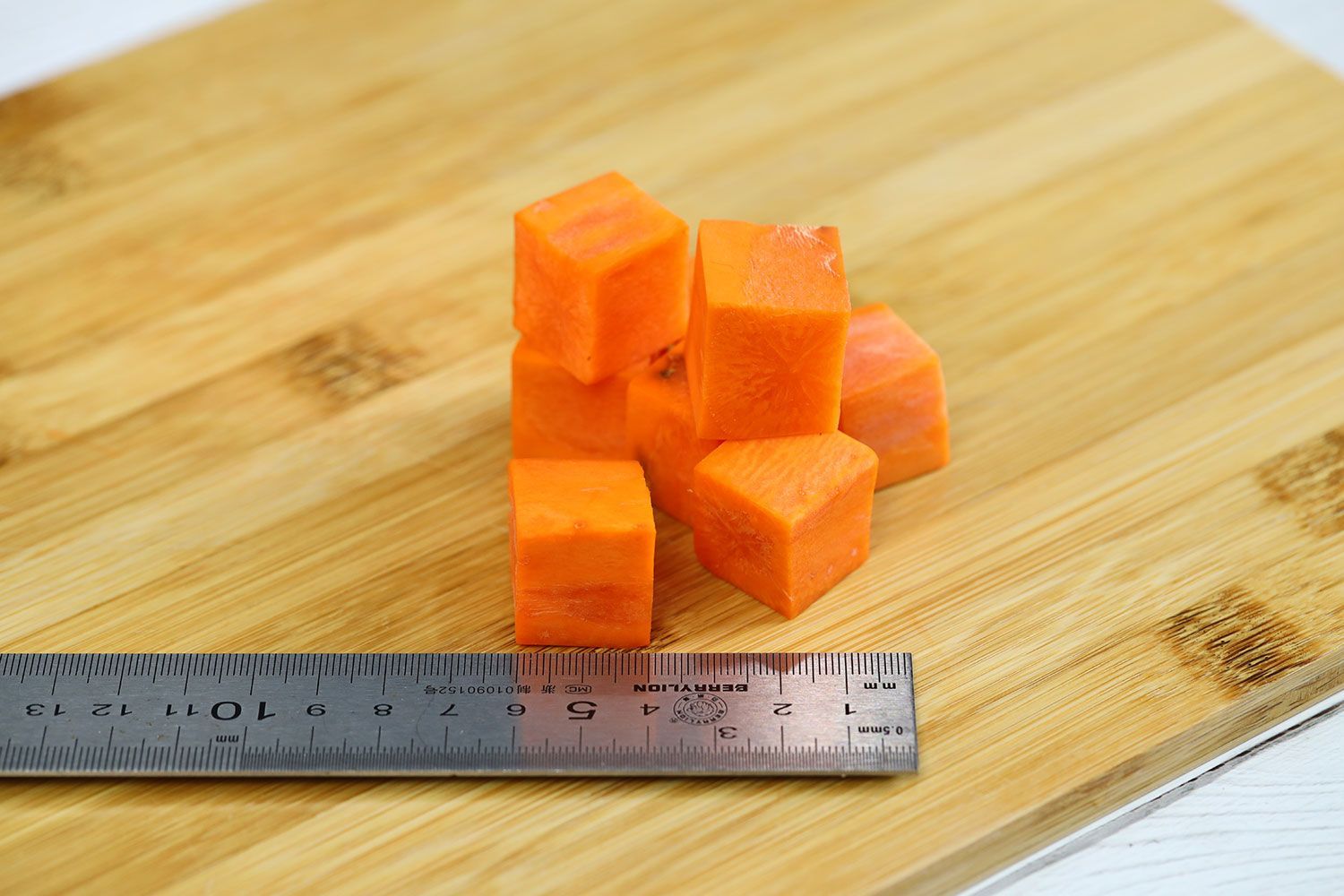
Applications
- Beef Stew: The carré cut is often used in beef stew to ensure the vegetables, such as carrots, potatoes, and onions, cook evenly and maintain their shape.
- Vegetable Soup: Carré cut is ideal for creating uniform pieces of vegetables such as carrots, celery, and potatoes for vegetable soups.
How to Perform the Carre Cut
Carré vegetables can be produced by cutting the pont neuf crosswise into three equal pieces. Here are the steps to produce carré cubes from scratch.
- Start with a vegetable, such as a carrot or potato, that has been trimmed to remove any rough or uneven parts.
- Cut the vegetable into ¾ inch thick slices.
- Cut the slices into strips that are also 3/4 inch wide.
- Take the strips and cut them into cubes that are 3/4 inch in size. Be sure to make the cuts as straight and uniform as possible to create a consistent dice.
Parmentier (Medium dice)
The parmentier is a medium-size dice with measurements corresponding to the Baton.
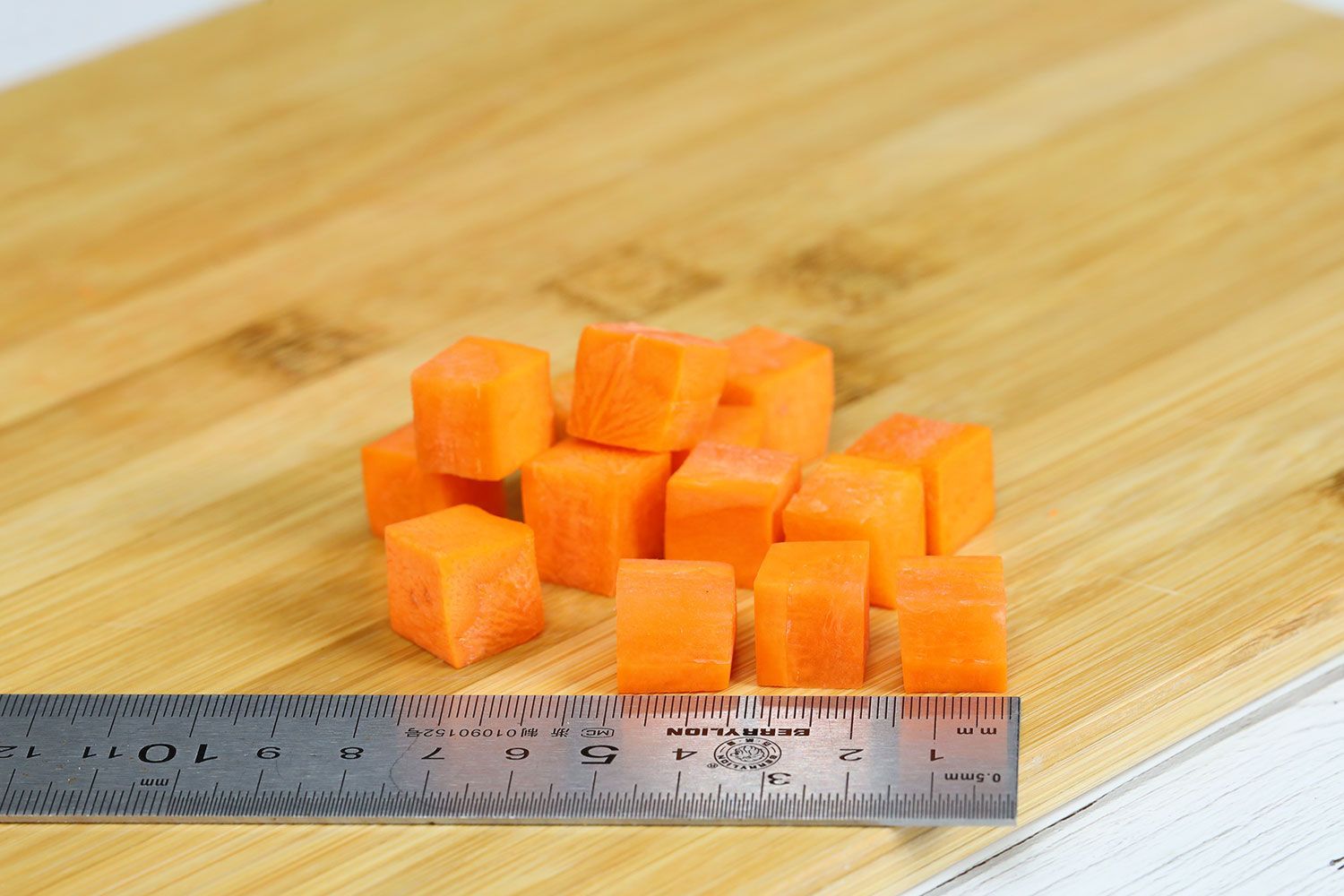
Applications
- Vegetable Soup: The parmentier dice cut is a common size for vegetables in soup, as it cooks quickly and creates a consistent texture throughout the soup.
- Salads: Parmentier cubes are easy to eat raw thanks to their medium size, which retains the vegetable’s crunchiness while not being too large to chew. You will find cubes of beets, turnips, potatoes, sweet potatoes, watermelon, cucumber, or pumpkin in a wide variety of salads.
How to Perform the Parmentier Cut
Cut the bâton crosswise into 4 - 5 equal cubes and you will get parmentier cubes. Here’s how to make the cubes from a whole fruit/vegetable.
- Start by cutting off both ends of the vegetable or root.
- Cut the vegetable lengthwise into 2 - 3 inches sections. Remove the four sides on each section to make a right rectangular prism.
- Cut the prisms into 1/2 inch thick slabs.
- Make vertical cuts about 1/2 inch apart along the length of each slab, making sure to keep the cuts straight and even.
- Turn the slab 90 degrees and make cuts about ½ inch apart. You now have parmentier cubes.
Macédoine (Small dice)
The macédoine is a small dice cut from the bâtonnet strip.
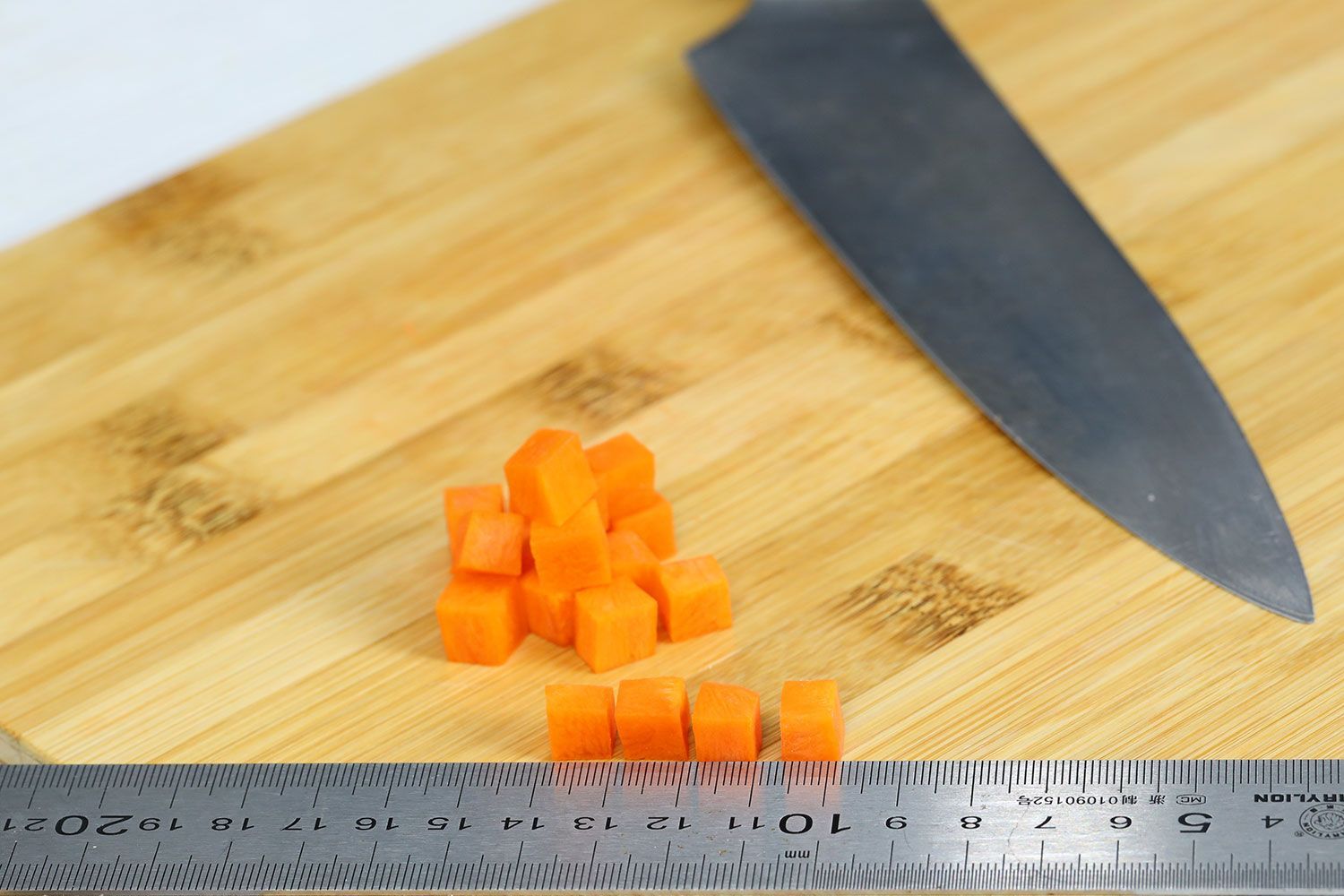
Applications
- Salads: Macédoine-cut fruits and vegetables can be seen in a wide variety of salads. There’s even a salad called Macédoina made of green beans and little dices of turnips, potatoes, and carrots coated in mayonnaise.
- Fried Rice: Little dices of carrots, mushroom, sausages, and pork make for the essential part of the Yangzhou fried rice and many other versions of fried rice.
- Garnish: Macédoine vegetables can be used as a garnish for a meat dish, while macédoine fruits can be used as a garnish for a dessert.
How to Perform the Macédoine Cut
Macédoine cubes can be achieved by dividing a bâtonnet strip crosswise into 10 equal parts. Here’s how to perform the cut from scratch.
- Start by cutting off both ends of the vegetable or root.
- Cut the vegetable crosswise into 2 - 3 inches sections. Remove the four sides on each section to make a right rectangular prism.
- Cut the prisms into 1/4 inch thick slabs.
- Make vertical cuts about 1/4 inch apart along the length of each slab, making sure to keep the cuts straight and even.
- Turn the slab 90 degrees and make cuts about 1/4 inch apart to make macédoine cubes.
Brunoise
The brunoise is a very small dice whose size corresponds to the julienne strip.

Applications
- Mirepoix/Cajun Trinity/Sofrito: The brunoise cut is an essential part of the classic French mirepoix, which is a combination of finely diced onions, carrots, and celery used as a base for many dishes. This cut is also used for vegetables in the Cajun Trinity and Sofrito.
- Salads: Little cubes of cucumbers, tomatoes, and peppers can be added to salads for added texture and flavor.
- Soups and stews: Brunoise cut vegetables are often used as a base for soups and stews, where they add flavor and help to thicken the dish.
- Garnishes: The small, uniform cubes created by the brunoise cut can be used as a garnish for a variety of dishes, such as roasted meats, fish dishes, and vegetable dishes.
How to Perform the Brunoise Cut
Brunoise cubes can be achieved by making 1/8 inch cuts crosswise on bâtonnet vegetables. Below are the steps to perform the cut from the beginning.
- Start by selecting a vegetable or fruit that is firm and preferably has a uniform shape. Wash and peel it if necessary, and trim off any ends. Remove the four sides on each section to make a right rectangular prism.
- Cut the vegetable crosswise into thin slices, about 1/8 inch thick.
- Stack several slices on top of each other and cut them into ⅛ inch-thick strips.
- Take the strips and cut them into ⅛ inch cubes.
Micro Brunoise (Fine Dice)
The fine brunoise is the dice version of the fine julienne.
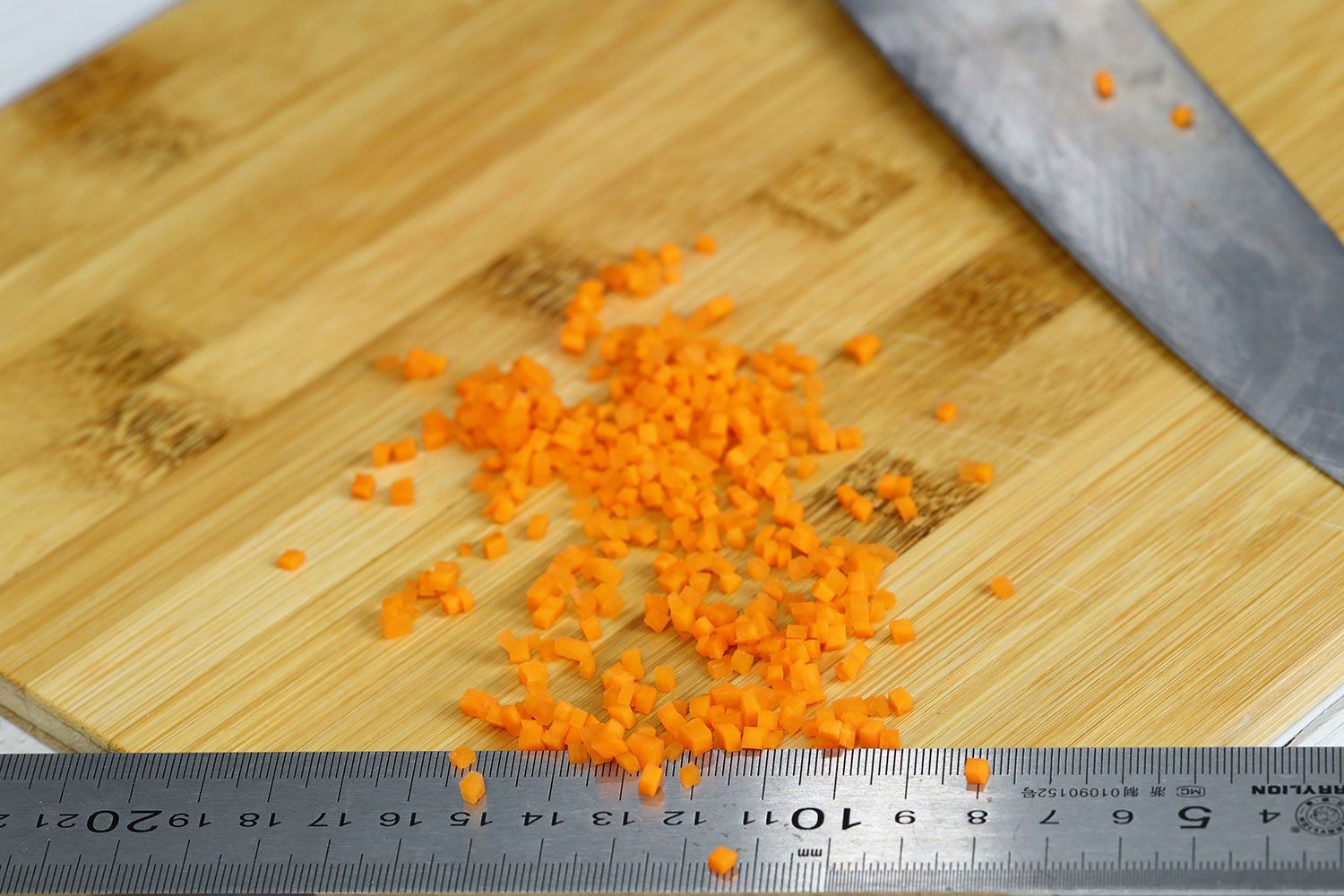
Applications
- Salsa: Fine brunoise is often used to create a smooth and uniform texture in fresh tomato salsa, along with diced onions and peppers.
- Garnishes: Fine brunoise is often used as a garnish for soups, stews, and salads to add a pop of color and texture. For example, a fine brunoise of red and yellow bell peppers can be sprinkled on top of a green salad to add visual appeal.
- Tartare: Fine brunoise is commonly used in steak tartare, a classic French dish made of finely chopped raw beef mixed with herbs, spices, and other seasonings.
How to Perform the Fine Brunoise Cut
You can get fine brunoise vegetables by cutting fine julienne strips crosswise into cubes. Here’s how to produce them from scratch.
- Wash and peel the vegetable, then cut it into 2 - 3 inches sections. Remove the four sides on each section to make a right rectangular prism.
- Use a sharp knife to make thin slices (1/16 inch) out of the prism.
- Stack several slices on top of each other and cut them into 1/16 inch thick strips.
- Take the strips and cut them into tiny cubes.
Other cuts
Apart from the strips and dices, there are many other ways to prepare your fruits and vegetables. The types of cuts below are more casual in terms of size—it depends a lot on the original size and shape of your vegetables as well as your intended use for them.
Paysanne
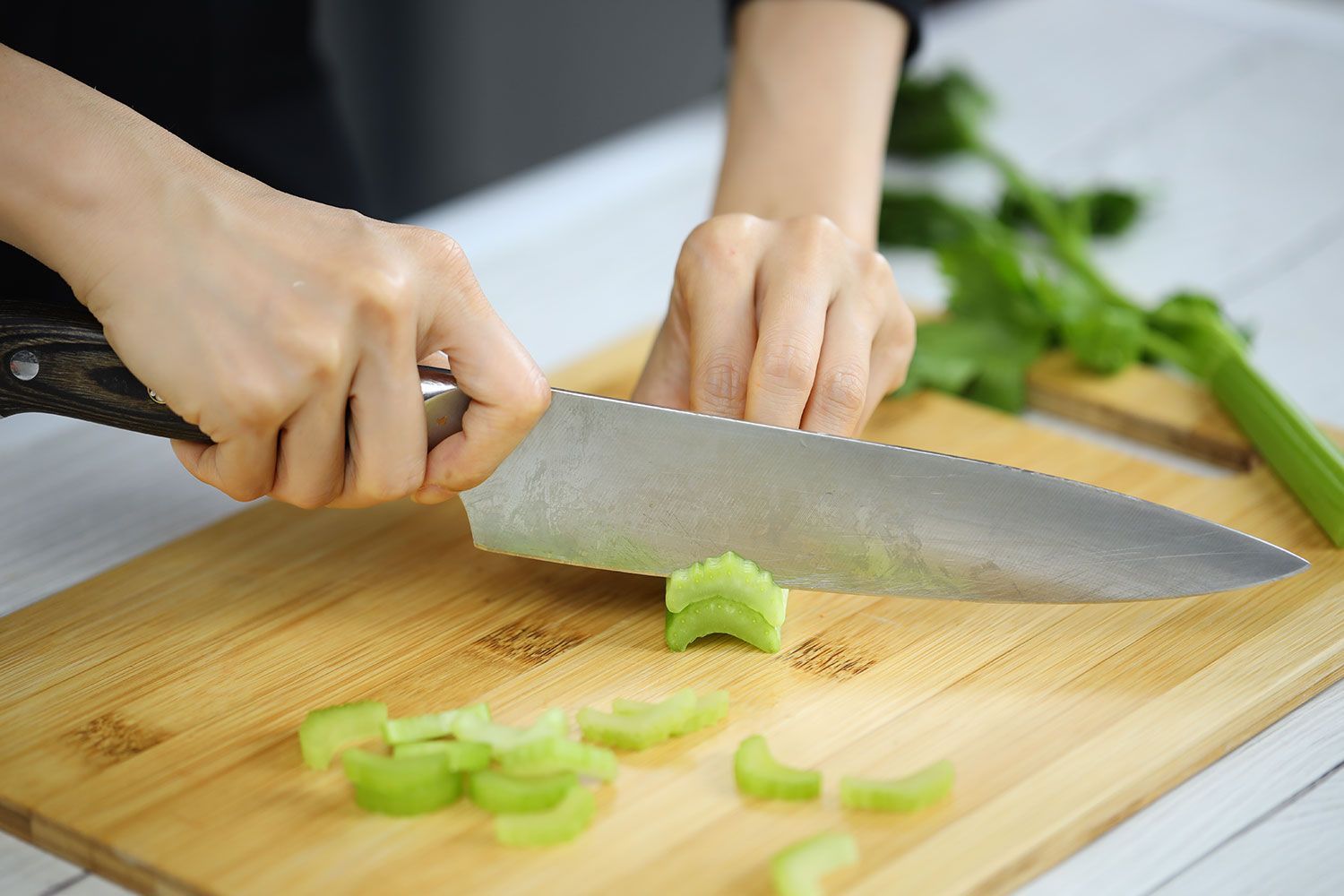
The paysanne is a culinary cut where vegetables are sliced into small pieces that are roughly 1/8 inch thick. The shape of the cut is determined by the natural shape of the vegetable, and the overall goal is to create uniform pieces that will cook evenly.
The term "paysanne" comes from the French word for "peasant," and this cut is often used in rustic or traditional dishes. It’s usually utilized in soups, stews, and other dishes where a consistent size and shape of vegetables is desired, but a more informal appearance is acceptable.
Rondelle
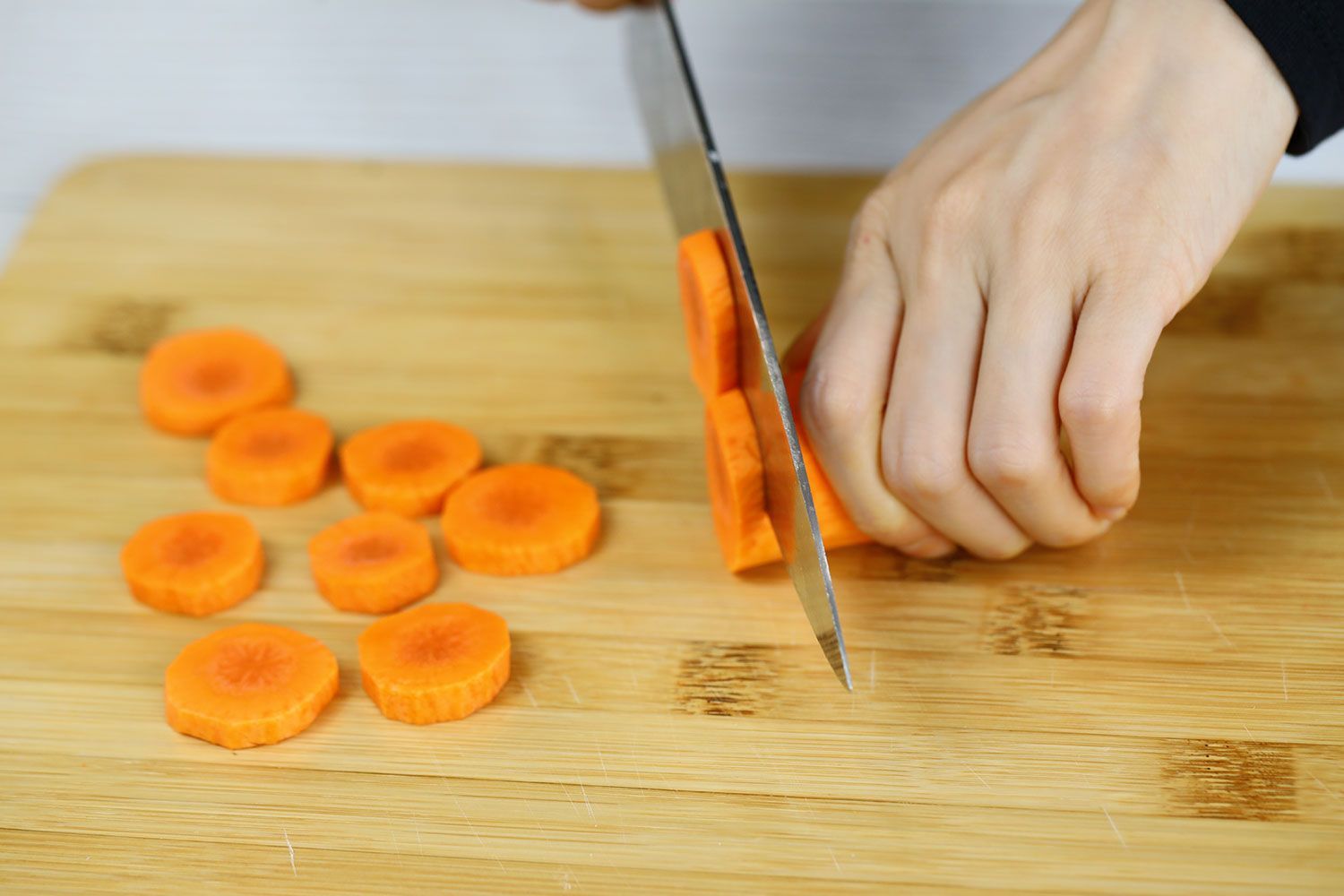
A rondelle cut involves slicing the vegetable perpendicular to its length, creating circular or disk-shaped pieces.
The rondelle cut is commonly used in dishes like salads, as a garnish, or in dishes where the even cooking of vegetables is important.
Wedges
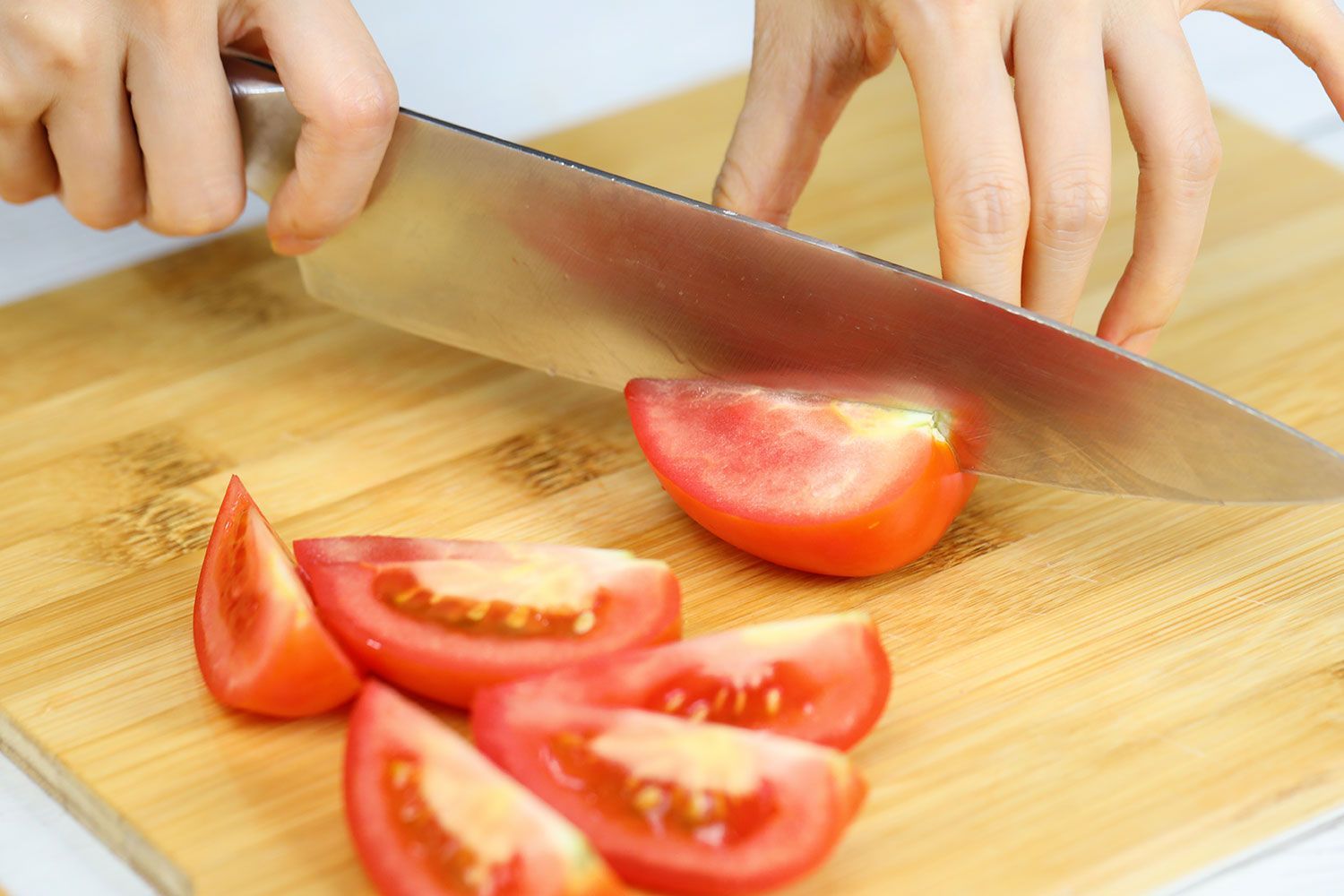
A wedge cut is a knife cut where a round- or oval-shaped vegetable or fruit is cut into wedges. This cut is achieved by dividing the vegetable or fruit in half, then cutting each half into wedge-shaped pieces.
The size of the wedges can vary depending on the desired presentation or recipe requirements. Wedge cuts are often used for vegetables such as potatoes, tomatoes, onions, or cabbages, as well as for fruits like apples, pineapples, or pears.
Wedge cuts can be utilized in various dishes, including roasted or baked vegetables and fruit salads. This cut can also be used as a garnish along with citrus fruits for cocktails or as a decorative touch in a salad.
Fermière/Quarter Slices
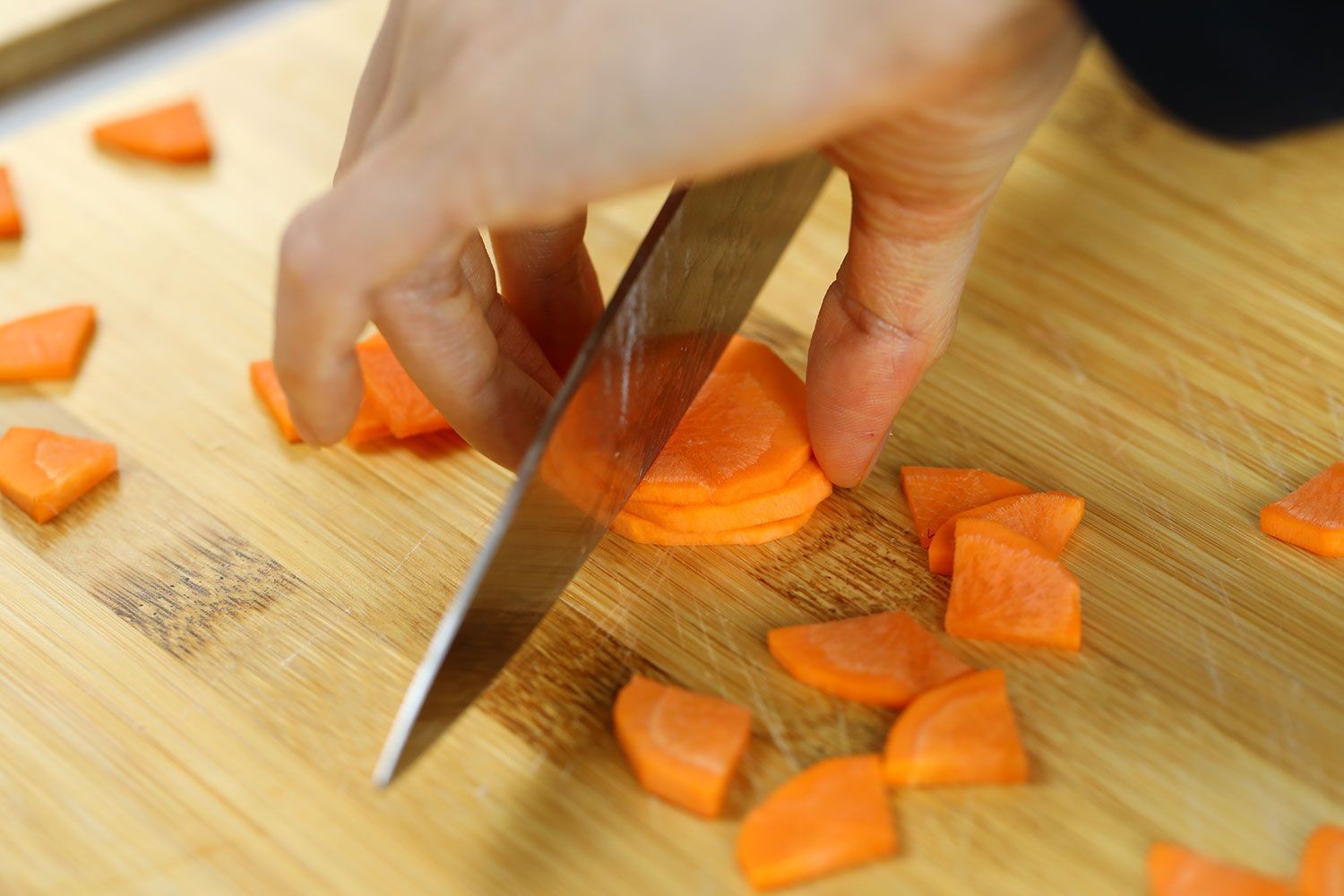
In culinary terms, a "quarter slice cut" typically refers to cutting a vegetable into four equal parts or quarters. This technique is often used to prepare vegetables that will be roasted, sautéed, or used in a salad. Quarter slicing is also commonly used for vegetables that are used as garnishes, such as radishes or cucumbers.
To quarter slice a vegetable, cut it in half lengthwise, and cut each half in half again, perpendicular to the first cut. This will give you four quarters. Slice these quarters to the thickness that the recipe calls for.
If the vegetable is long, dividing it crosswise into several sections beforehand will make it safer and easier to perform the quarter-slice cut.
Bias
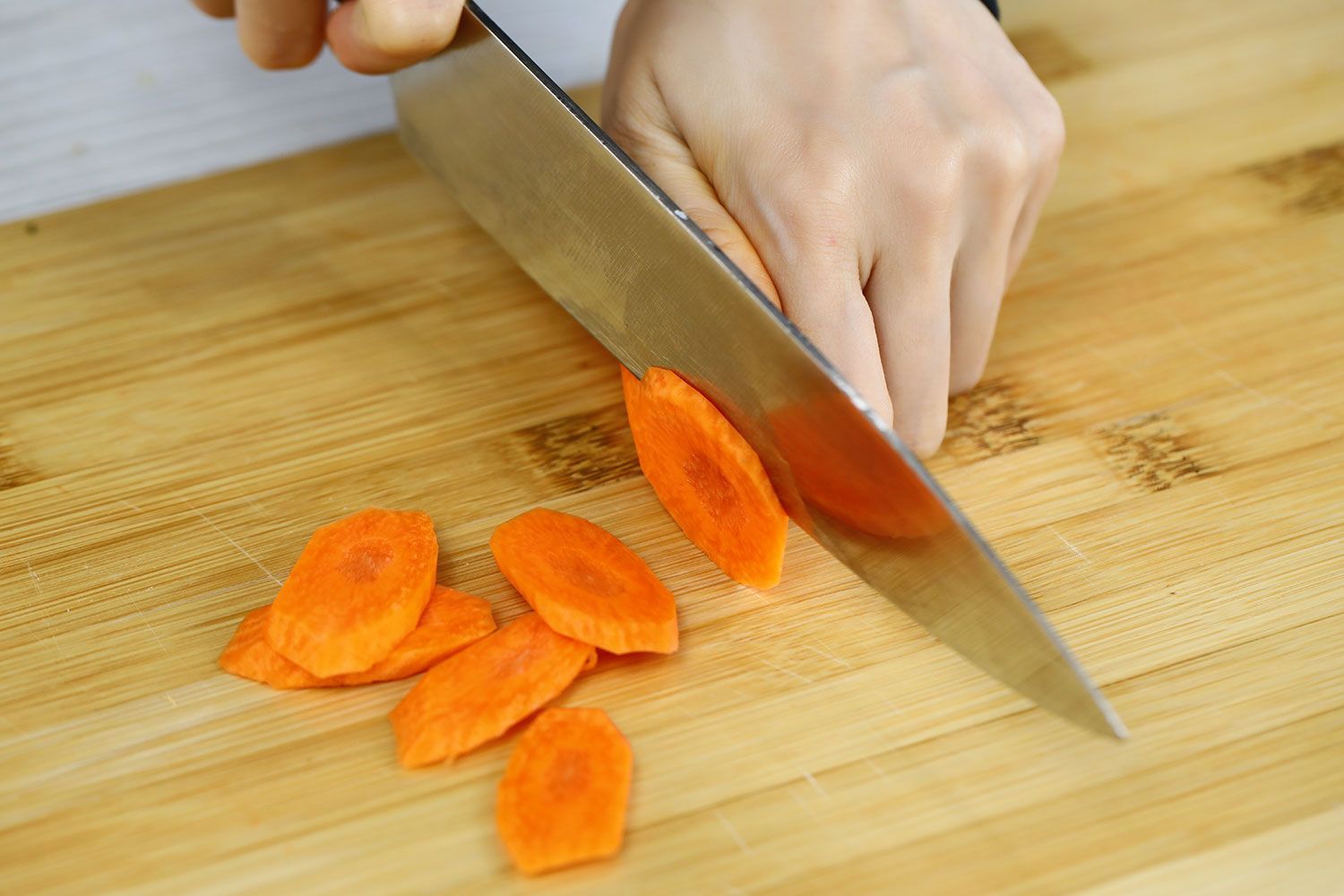
A diagonal cut, also known as a bias cut, is a cutting technique where the vegetable is sliced at an angle (45 - 60 degrees). This cut creates elongated pieces of vegetables that have a larger surface area compared to a straight cut. This can create a more interesting and dynamic presentation on the plate.
Some vegetables that are commonly cut diagonally include carrots, zucchini, celery, and potatoes. This cutting technique is particularly useful for stir-fries, where the vegetables need to cook quickly and evenly.
Obliques/Roll Cuts
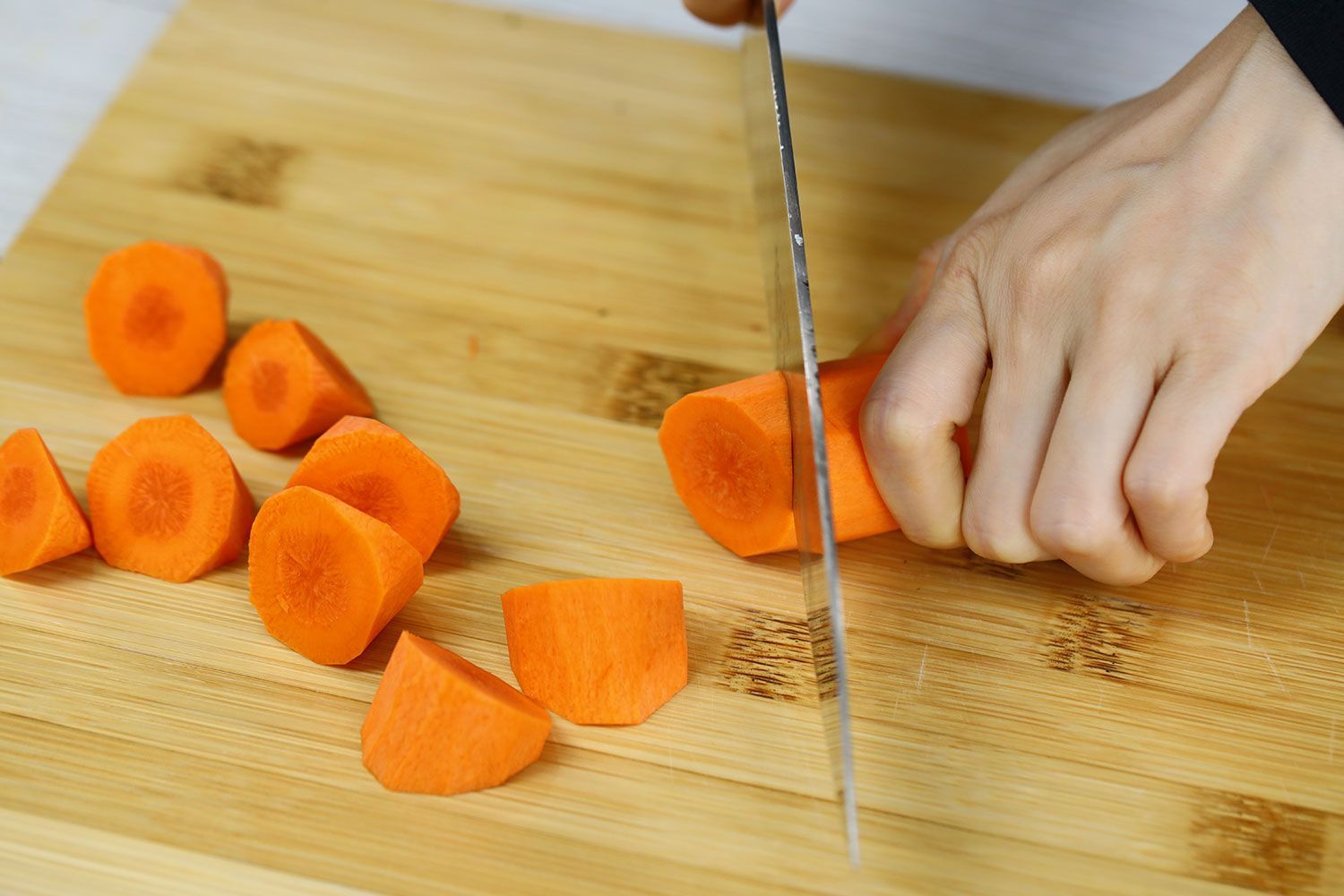
The rolling cut is a technique used to cut long, cylindrical vegetables. You roll the vegetable at 90-degree angles and make 45-degree cuts to create obliques or wedge-like slices.
The oblique cut creates more surface area so the spices can penetrate the food more easily. Food also cooks faster with this cut. The thickness allows the vegetable to retain much of its original flavors and texture, and is thus ideal for glazing, roasting, stews, soups, and salads.
Mince

Mincing is a technique in cooking where food, usually herbs, vegetables, or meat, is finely chopped into small, uniform pieces using a sharp knife, food processor, or other kitchen tools. Mincing food can enhance its flavor and allow it to blend better with other ingredients.
Mincing is commonly used in dishes like sauces, stews, soups, salads, and meat dishes. For example, minced garlic or onions can be used as a base for sauces or soups, while minced meat can be used in dishes like meatballs or burgers.
Most chefs prefer a Western-style chef’s knife with a curvy belly for mincing, as it can rock on the cutting board, making it very efficient for mincing. If you find yourself mincing a lot of garlic or herbs, David Lewis from Kitchen Ambition recommends using a mezzaluna knife for “it is the absolute fastest way to power through a boatload of aromatics without crushing them”.
Chiffonade

The chiffonade cut is a technique with which you cut herbs or leaves into long, thin strips (ribbons).
This technique is commonly used for ingredients such as basil, spinach, kale, and lettuce. Chiffonade cut is often used for garnishing or adding texture to dishes, such as in salads, soups, or pasta dishes.
To chiffonade, stack the leaves on top of one another, roll them tightly into each other, and slice across the roll with a sharp knife to create ⅛ inch or thinner strips. It’s important that you use a sharp knife to prevent causing bruises on the leaves.
Slices
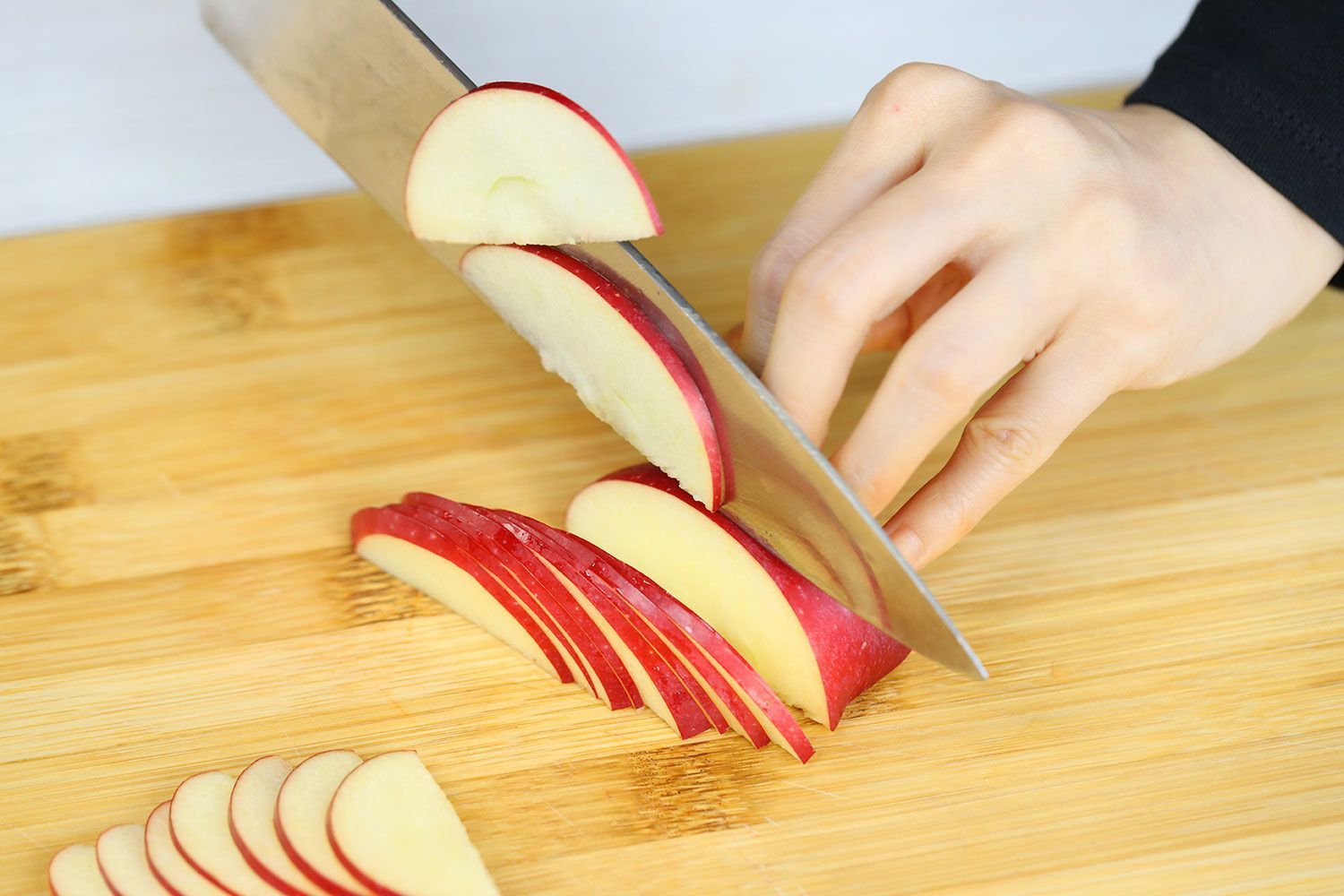
A slice cut refers to cutting food into thin, flat pieces of a relatively uniform thickness. This technique is commonly used for meats, vegetables, fruits, and bread.
Sliced food can be used in a variety of dishes, such as sandwiches, stir-fries, salads, and more. The thickness of the slice can vary depending on the desired outcome and recipe specifications. A sharp knife is essential for achieving clean and precise slices. Knives with pimples along their blade, such as the santoku, are ideal for this cut, as they can prevent the food from sticking to the blade and slowing you down.
Tips on Performing the Different Types of Culinary Cuts
We asked experienced cooks and chefs to share their advice to help beginners ensure safety and improve precision and speed while cutting food. Here are our top tips from the experts.
- Use the Right Equipment
A sharp knife and stable cutting board always help when cutting food, but they’re especially important when you’re aiming for precision. Ensure your cutting board is stable and won't slide around during cutting. A non-slip mat or a damp cloth under the cutting board can help keep it in place. (Tuyet Pham, Healthy Recipes 101)
- Adopt the "Claw Grip" Technique
When holding the vegetable you're cutting, curl your fingertips inward, tucking them under your knuckles, and use your knuckles as a guide for the knife. This technique keeps your fingers safely away from the blade.
- Don’t Rush It
David Lewis advises that you should not take shortcuts or try to go too fast if you're practicing your knife skills. That's where accidents happen. Be slow and methodical. Speed should come through repetition, not brute force.
- Consistency Is the Key
Unless you're working in a professional kitchen, prepping dishes at scale, then consistency is always going to be more important than precision. Understanding the classic dimensions is quite helpful, but don't stress if you're not nailing the exact measurements with your cuts. The thing you want to avoid is a huge variance in sizes because that means some pieces may undercook while others come out mushy and overdone.





